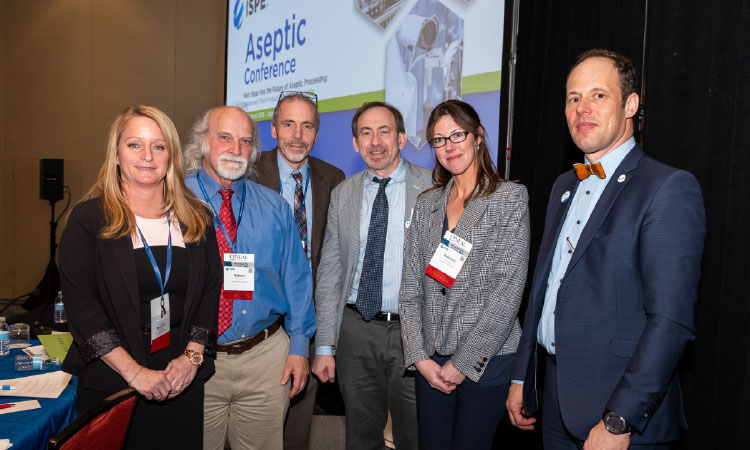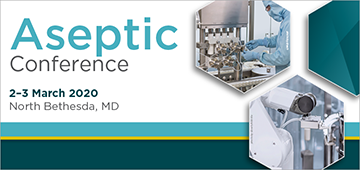Interactive Regulatory Panel Addresses Multiple Aseptic Issues

The Interactive Regulatory Panel session at the end of the 2019 ISPE Aseptic Conference is one of the most popular conference sessions each year, and the 19 March session at this year’s conference was no exception.
Regulators from the US Food and Drug Administration (FDA) addressed a broad range of questions from attendees on topics from restricted access barrier systems (RABS) to smoke studies and artificial intelligence in the aseptic arena.
Panel Members
This year’s panel roster:
Sausville acted as moderator for the session and participated in the discussion. He noted that the FDA has been coming to the ISPE Aseptic Conference for 25 years and observed the emphasis on cell culture at this year’s conference.
Q & A
The following are selected questions posed (in bold) and the panel’s responses.
We have a conventional filling line in operation and we are considering upgrading to a RABS. However, we are afraid that we make our current line look bad when we submit. How can we overcome this?
If the questioner is adding a new line in addition to a legacy line, then a RABS or isolator is definitely recommended, Friedman said. He noted that adding a RABS around an existing line will not necessarily make it safer and, in fact, could have unintended consequences or risks. The aseptic processing line should be replaced or thoroughly redesigned.
“We do want to note that we encourage and hope that any new line would be a RABS or an isolator,” Friedman added.
How do “live” viable monitoring systems (fluorescence and light scattering) fit in with traditional EM [environmental monitoring] setups? Can settle plates be removed if utilized?
Because vendor products may vary, Friedman said the panel would not “make large, broad pronouncements.” If the product under consideration is good, and the user has qualified it, the product could be a good addition to the aseptic processing line. He noted that some methods allowing microbial capture and identification should still be in place and active air monitors are recommended. “The origins of microbial contamination can be understood, but you must know the hazards to address them and the route of contamination. Microbe identification is a key part of any investigation.”
Ensor said that emerging technologies may be used: “Qualify them to meet testing needs and have backups” to be able to identify organisms.
What are the expectations for automated glove testing for nonisolator applications, given that existing technology cannot detect holes smaller than 100 micron?
Dombrowski noted that by asking this question, the questioner showed that they understood the limits of testing systems and current capabilities of visual eye and existing systems. She noted the potential to investigate whether a higher rate of failure is attributed to docking or a system malfunction. “Expect that you are looking for leaks in those systems,” she suggested. “Focus on some limits and capabilities of the systems and considerations for alternates.”
Our firm is moving toward single-use bulk bags. Is a postuse integrity test of the bag necessary?
Lynch responded that there are two categories, depending on what is being stored. Either sterile bulk or bioburden controlled bulk. For sterile bulk CCIT [container closure integrity control] qualification or stability testing is expected to show whether the bag maintains sterility. Lynch’s division focuses on integrity and sterility; this scenario may warrant contacting a product office expert. “If you have a bioburden control bulk in the bags, we are not recommending that pre- or post-integrity inspecting be required at this time.”
Dombrowski commented on incoming controls for single-use technologies for bagging materials, noting that it is necessary to identify the vital components upon receipt of that system. “What is important in the single-use technology? All the different ports and connections as part of incoming component controls?”
What are the expectations for glove testing for an open RABS or a barrier with glove ports that is not quite a RABS? Most regulations are for isolators.
Sausville noted that there are no US regulations for isolators, only guidance. Dombrowski said this relates to the previous discussion about glove testing. “The onus is on the operations/facility to understand the risks of the system you are using to detect leaks in the system,” she said. While the previous response addressed leak detection, other considerations include the ergonomics of glove locations. “Are there risks in those glove ports that could be addressed through simple changes in design?” Dombrowski asked.
Do all interventions need to have a separate smoke study? Or can setup-type interventions be utilized to justify?
Friedman explained that smoke studies are a little different from media fill; you can still perform interventions in a program in a representative way, depending on the severity of the intervention. “Smoke studies may be able to do more grouping of types of interventions that occur,” he said. However, he noted that smoke studies are subject to inspection and should include rationales and representative interventions.

Does the FDA allow the use of AI [artificial intelligence] in the product manufacturing process? Or is there some limitation to introduce AI to process?
Dombrowski said there is no prohibition on AI use in manufacturing processes and noted some ways it is used in training simulations for operators. “There are limitations and you should understand what they are to your process. What is the risk of introducing the new technology? It is the same questioning as with any new technology. We don’t have a prohibition, but we need to understand what the system is being designed for.” She noted that the question was broad; therefore, her response was broad.
“Humans are still responsible for monitoring and supervising operations,” Friedman added. “Humans write software.” Sometimes, we have to do work-arounds for unexpected scenarios encountered in software, or the right type of actions were not prescribed by the software to address those risks. Therefore, “software has limitations and you should not expect it to be a panacea.” Complexity and complex processes warrant consideration. “Don’t be afraid, but don’t be overconfident that AI will solve everything. Risks from new technology will be different, but there will still be risks.”
What is the expectation for qualification of aseptic operators? Can we create a separate media fill/process simulation solely for the qualification of operators?
“It’s a media fill, not a practice run—it counts,” Friedman said. He also noted that the FDA has seen an incremental introduction of operators into line interactions. “There’s that kind of apprenticeship that generally takes place. A lot of companies do broth testing and have them do some work in a hood with broth exposed to see if there is good aseptic technique.” The FDA sends its own staff to hands-on aseptic processing courses, and Friedman noted that there are various options for the training, including in-house opportunities at some companies, offerings at local universities, and training via partnerships between industry and universities.
Don’t be afraid, but don’t be overconfident that artificial intelligence will solve everything.
Ensor asked, “Why do you need to qualify operators outside of the media fill process? Is there a shortage? If [a manufacturer is] carving out the qualification just for operators and not having media fill, what does that do for any product made on that line? It has to be a media fill and it will count, and you are accountable if things fail. Build skills and talents of aseptic processors so when there is a media fill opportunity they will be successful.”
With the movement toward closed system, what is the expectation of sterile filtration in relation to the filling equipment? Is it better to have preuse, poststerilization integrity testing?
Regarding sterile filtration prior to filling, Lynch said, “We can’t cover every scenario. There are three general ways: SIP [sterilize in place], do connection in grade A, or use a sterile connect system. The latter is what many have chosen; as long as you are following established procedures and GMP, these have been acceptable for years in CBER from the biological side. So you could use it on grade C.”
Ensor added, “In CDER we have seen them in biologics or biosimilars in large molecules. Typically, this is done in the grade B area.”
Friedman said, “A true, fully exposed aseptic connection would be grade A. We have seen leaks at times and other deviations that would have to be investigated. There are different vendors for closed systems. Whether truly closed or not is a question. You have to address it, just like disposable bags: make sure the incoming closed system is really reliable.”
Addressing integrity testing of sterile filters, Sausville asked, “Should you do a preuse, poststerilization integrity test? We expect a postuse integrity test, but not sure if you need to do a preuse test.”
Can you tell us how a modern, highly automated BFS [blow/fill/seal] system compares to isolators and cRABS [closed RABS] fill/finish systems? (Related to work from Ljungvist, Reinmuller, Sinclair, and Tallentire.) [Addressed to Friedman]
Friedman said that BFS technology is better than cRABS because BFS does not require stopping to resterilize. “cRABSs are often manually disinfected but some are autodecontaminated and just as good as BFS.”
In response to a sterility failure event, what is the expectation for recovery and investigation prior to resuming commercial production?
Dombrowski said it could range from days to weeks. “Understand the scope of the impact of the failure of sterility. Get a very thorough understanding of the potential root cause” of the infection. “Different root cause analyses can be gone through to understand how the event occurred. Understand corrective actions to address the root cause and preventive actions moving forward in addition to the scope and impact of other products,” said Dombrowski.
Friedman added, “That’s a good answer. Look at existing guidance! Baseline for sterility failure event, look at aseptic guidance. Understand routes of contamination that can exist.” He urged the attendees to look at all possibilities, including those related to original design, because the source of contamination could be further away than you might think.
What is the FDA position on quantity filled during routine media fills?
Ensor said to look at the FDA’s 2004 aseptic manufacturing guidance. The general rule is 5,000 to 10,000 units for larger batch sizes, but media fill expectations for a smaller batch should be largest batch size. Regarding exposure time, Ensor said to expose components used in the manufacturing process to worst-case environmental contamination scenarios. This should be done for the same situation for the longest filling time; piggyback after production and media fill after; or start/stop. Production parameters should be assessed to see how to capture all worst-case scenarios. Regarding frequency expectations for a routine lyophilization process, the best recommendation is to matrix those to different sizes that need to be lyophilized. If there are different lyophilizers, the same or similar lyophilizers should be checked and the differences noted for the agency. Finally, for frequency of interventions, Ensor said to, perform worst-case checks through media fills.
Lyo [lyophilized] vial transport to loading through full HEPA coverage workspace using closed carts: Should carts also have HEPA coverage or is ceiling HEPA sufficient?
Lynch said, “We don’t recommend just ceiling HEPA as sufficient coverage, given stoppers are only partially seated at this point. We prefer an automated transfer system if possible with grade A coverage over that. From the biologics side, a lot of firms are going to transfer trolleys with full HEPA availability within the transfer trolley.”
Friedman added, “Closed carts without HEPA filters—we have seen media fill failures with lyo transfer. Transfer really is a critical control point. A cart without a HEPA filter is a dead space. When taking exposed units out, there is a real chance to contaminate. Carts with HEPAs have their own deals. Integrated, automated transfer from filling machine to the lyophilizer is where you should be,” and that will be economical for most lines. Admittedly, this might not be the case for very small batch sizes.
Is it reasonable to risk-justify using two-way traffic flow and combined PALS/MALS [personal airlock system/material airlock system] airlocks when transitioning into the grade C background surrounding an isolator?
Dombrowski said it can be reasonable to risk-justify that. The size of operations may be a valid reason for facility design, although she noted that it is not ideal. Separating those processes would be more appropriate; however, “there is no hard-and-fast yea or nay.”
Friedman noted there are myriad facilities, and all are different. “In a conventional facility, it is frowned on, less important in isolator technology. There are reasons for unidirectional material and personnel flow even in an isolator paradigm,” he said, which prevented him from being able to answer the question.
Can open RABS be surrounded by grade C environment? Modifications: (1) alarmed airflow sensors at critical room/RABS interfaces; (2) frequent VHP [vaporized hydrogen peroxide sterilization] of RABS and room; (3) strict closed-door SOP (like isolator)?
Lynch said it would typically be a grade B environment, depending on how closed around the unit is, but this is dependent on many specifics. In a grade C environment, Friedman can only imagine having a highly automated isolator unit.
What is the driver around sampling the external surrounding environment (grade A/B) of aseptic production when there is an ample amount of sampling in the critical processing area as well as barriers?
Dombrowski said, “Broadly, a continual state of understanding of your operations is the driver. Inputs: personnel, materials, daily facility and equipment functioning, equipment moving into spaces—there is a lot of activity in these spaces that would lend to driving force for understanding what is happening in that environment in that dynamic state. Each under its own separate controls is one separate aspect.”
Friedman agreed that there is a need to understand the factors raised by Dombrowski. He said, “There’s nothing like aseptic processing to make everyone humble! Problems may come up 10 years into an operation, and it could take a year to resolve.” Dombrowski concurred, saying, “There are so many sources of variability.”
What is the agency’s stance on rejects during the filling process vs. inspection process where only critical rejects are allowed to be removed? Specifically for partially stoppered lyophilized products.
Sausville asked, “Simulation in aseptic process? It depends. Some will need to be incubated.”
Ensor asked, “What denotes a critical reject? Learn about process or state of control; anything that could be incubated, you could learn information about your system. Identification for rejects should be very similar to process simulation and production. If there are any critical rejects, it is important to investigate the root cause. If intact, where is the organism coming from?”
What is the opinion and recommendation for using a facility for both GMP and non-GMP activities?
Sausville said it depends on the size of the facility—some do both.
Dombrowski had no blanket opinion. She asked about controls and differentiating requirements, as well as differences in requirements, for pharmaceutical products. She does not see this occurring on the same lines in research but some of the same requirements apply.
Sausville added that cleaning and changeover would be important in this scenario.
Friedman suggested following the World Health Organization’s guidelines, stating that nonpharmaceutical and pharmaceutical products should not be made in the same facility. On using GMP and non-GMP standards, he asked, “Isn’t it hard enough to get people to follow one standard?”
When validating a lyo process at a CMO, three lyo units are considered identical but their qualifications are 14+ years old. What type of validation is required? (One run in each? How much mapping?)
Ensor noted, “When things are considered identical, what does that mean exactly? We need to know. Have the old lyophilizers been requalified? Use them once annually on a media fill. If older equipment is not qualified, you would do initial qualification, and have a defined protocol for qualification and requalification.”
Lynch agreed, suggesting that manufacturers “have a validation master plan with appropriate requalify parameters and timelines.” Dombrowski asked, “Older equipment, changes—how can you consider them identical with life-cycle changes?”
Save the date for the 2020 ISPE Aseptic Conference in Rockville, MD, USA, 2 – 3 March. Visit the conference website to get a sneak peak of what to expect at the 2020 ISPE Aseptic Conference







